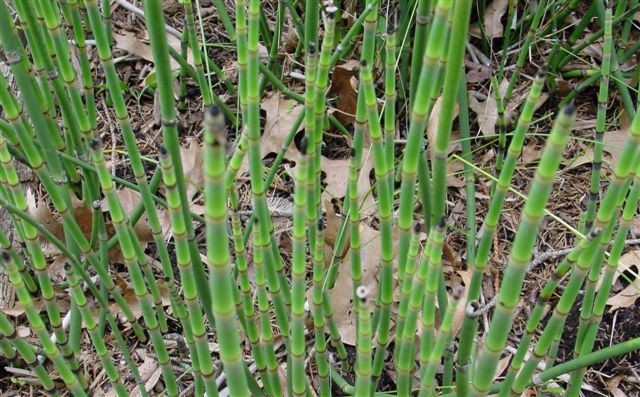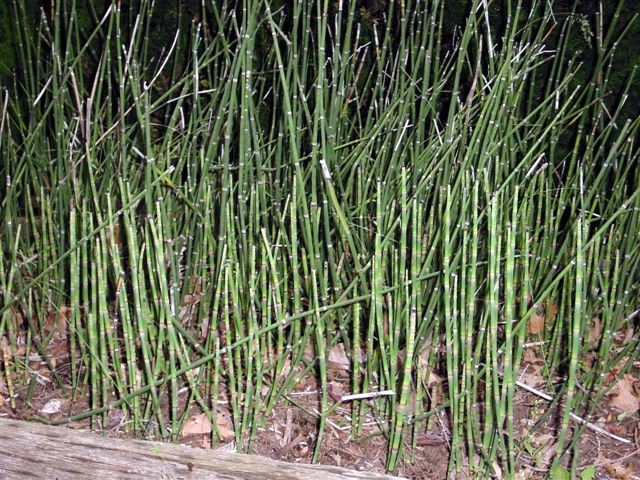EQUISETUM HYEMALE
WHAT IT IS
The above pictured plants have many names - Scouring Rush, Dutch Rush, and Horsetail. There are hundreds of species of Equisetum, the one pictured here - and the only one useful to clarinetists - is Equisetum hyemale. These living fossils have been around for the past 300 million years, a part of the Carboniferous or Coal Age, and are the last living example of "Sphenophytes" (plants having straight stems, with branches and leaves arranged in regular whorls). "Scouring Rush" gets its name from times past when it was used for scrubbing pans and polishing all sorts of objects, because its ribbed and furrowed stem cells have a high percentage of silica and feel abrasive to the touch. The Equisetum species are in the family, Equisetaceae, which is in the plant division, Pteridophyta. This means that Equisetum species are closely related to ferns, and their reproductive spores are dispersed by the winds. The popular and widely used name "Horsetail" comes from the Latin words equus (horse) and seta (bristle), from the peculiar bristly appearance of the jointed stems of the plants.
HOW IT APPEARS TO THE EYE
The plant bears no leaves, and looks almost like a pot of green bamboo stakes that florists use to support unusually tall plants. The stems are jointed and they come apart at each joint - usually with a loud popping sound. Where the tips (strobilis) are missing, the stems end in a circular depression with brown edges. It is not uncommon to see straw-brown dead tips on top of a healthy green stem. This is probably a safety valve for drought conditions. When water is more plentiful, the plant usually sends out shoots from the top edge of the remaining stem. These little spikes adhere to the stem as though they were welded there. The hyemale species has an insatiable desire to keep its roots very wet. It cannot be over-watered, and is happy to sit in large puddles - in fact, it thrives profusely in watery conditions. Its close relative Equisetum arvense has very little thirst, and can grow and thrive on dry, hard-packed soils.

HOW IT REPRODUCES
The stems spring from a creeping rhizome, or root-stock, which produces at its joints, a number of roots. Reproduction is by spores, which produce minute plant bodies who in turn produce sperm, eggs and a tiny little plant. The leafless stems are light brown in color with a spore bearing cone (strobilis) on top. These emerge in early spring and die back soon after the spores shed. The plants are maintained by smalll tubers that store food reserves and an extensive rhizome system that penetrates to a great depth in the soil.

WHERE IT GROWS
Equisetum grows profusely in many parts of the United States and Europe. In the United States, Michigan is the center of diversity for the genus with nine species. As a native of New York state, I remember - as a young boy - the fun we had pulling the plants out of the ground, snapping out the stem segments and throwing them at each other, using them instead of match sticks when we played cards, or otherwise, just finding the plant very interesting and unusual. Little did I know of any value associated with this strange looking plant. But for any clarinetist with a bit of ingenuity and perseverance it will become one of the most indispensable tools for adjusting clarinet reeds. Found along railroad beds, in loamy areas near water, and many times growing along highway embankments, one important area centers along N.Y. route 9 about 70 miles south of Montreal, near the Ausable River. One can see it growing profusely amid the heavy growth of under-brush, deciduous and evergreen trees that comprise the landscape of that area.
I began growing Equisetum Hyemale in the year 2000, after having exported large pots of it from the very areas I spoke about in the above paragraph. It has flourished unbelievably well despite the very hot summer weather - which sometimes continues without rain for long periods of time. It likes a moist soil and thriving in it, becomes very invasive under extremely wet conditions. This plant that holds very little botanical value - other than it is 300 million years old - and is not high on the list of information touted by many expert botanists. The state of New Jersey does not have many places where one can find the Equisetum hyemale species. Walking north along the canal out of Lambertville, one can spot small areas where Equisetum arvense - which has no value to clarinetists - grows in sparse quantities, but no hyemale.

DON'T "RUSH" AND BUY IT!
In the clarinet world, using "Dutch Rush" to make reed adjustments is a necessary process. Young students - even those who know nothing about 'reed fixing' - enjoy carrying around in their clarinet cases, a box of Equisetum they have purchases from the local music store, or a mail order catalog. I find that they do this for a few reasons: a) They have heard about it and subsequently bought some but don't know how to use it. b) Their teachers use it (hopefully it isn't in the same condition as the store-bought stuff, if it is, they are both in trouble and it doesn't say much for the teacher).
Music dealers who sell small plastic boxes of "Dutch Rush" probably don't know any more about it than the unsuspecting students who buy it, they just market the product. They sell it with the understanding that it is a reed fixing tool, having no idea how it should be aged and cured for it to be usable. When the small plastic box is opened, one finds a bright green tubular 'weed' soft in structure and chopped off at each end so one can see through it like a sipping straw. The student knows before hand - for whatever reason - that this weed must be wet to be used to scrape a clarinet reed, so they wet it and begin to scrape somewhere on the reed. To their chagrin and total amazement, the whole thing collapses into an ugly pulpy mess. So much for an expenditure of about $4.50.
Equisetum must be cured, and that takes time. It is picked in its bright green state, dried over a period of time in its original shape (long stems), and when it has hardened and turned a grayish green it is ready to be broken into the small segments. Each segment must be closed at one end for it not to become waterlogged in the wetting process each time you use it to scrape a reed. If you can't create a vacuum when drawing air from each segment, the piece is probably going to be too porous and will break down very soon after you begin to use it. Each piece of rush isn't perfect and you won't be able to successfully use all, but of necessity it must be CLOSED AT ONE END. This scenario is different from what is sold as the commercial product, but need not preclude you from obtaining a good source of Equisetum.
HOW TO PREPARE IT FOR REED SCRAPING
After you have chosen select pieces for scraping, the following can be helpful:
1) Wet the open end either in you mouth or in a glass with a half inch of water for about 3 minutes, or until the end is saturated. Since you are going to wet it in your mouth each time you use it, mouth soaking is probably the best.
2) Press the wet end between your index finger and thumb thereby squeezing out most of the water.
3) Clamp the end with a device that forces the tip closed i.e. paper clip, place under a heavy object, and if you don't have to use it immediately, let it dry.
4) When dry, remove the clamp and rewet the piece. When wet, and with a sharp knife or single edge razor blade, cut off the tip.
Now you are ready to use it for reed scraping. Remember, that each time you use each piece, it must be moistened in your mouth to prevent crumbling.
SUMMARY
Plant supply houses and laboratories will sell the good stuff - you might have to dry it yourself, but in the end, the results will be worth it. There may be many clarinetist or others interested in raising Equisetum. This writer can give you the proper information about what it is, the condition it should be in in order to use it, and how it is used in adjusting the clarinet reed. Don't hesitate to ask. E-mail: mckinney@tcnj.edu